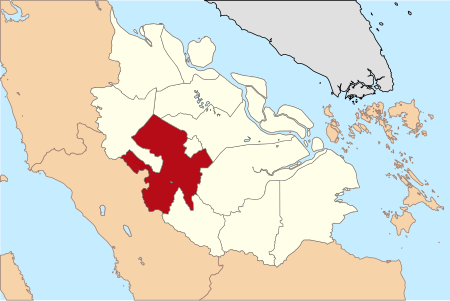Jagdish Mahto
| |||||||||||||||||||||||||
Read other articles:

VIII Fighter CommandP-51D Mustangs of the command's groups[note 1]Active1942–1946Country United StatesBranch United States Air ForceRoleFighter escortEngagementsEuropean Theater of Operations[1]CommandersNotablecommandersBrigadier General Frank O'Driscoll Hunter Major General William Ellsworth KepnerInsigniaVIII Fighter Command emblem[note 2][1]Military unit The VIII Fighter Command was a United States Army Air Forces unit of command above the wings an…
Archaeological site in Ohio, United States United States historic placeRaleigh MoundU.S. National Register of Historic Places Streetside viewShow map of OhioShow map of the United StatesLocationMound St., Fredericktown, Ohio[2]Coordinates40°28′25″N 82°32′35″W / 40.47361°N 82.54306°W / 40.47361; -82.54306AreaLess than 1 acre (0.40 ha)NRHP reference No.75001445[1]Added to NRHPOctober 14, 1975 The Raleigh Mound (33KN32[1]) i…

Campionato mondiale di hockey su ghiaccio Under-20 20062006 IIHF World U20 Championship Competizione Campionato mondiale di hockey su ghiaccio Under-20 Sport Hockey su ghiaccio Edizione XXX Organizzatore IIHF Date 26 dicembre 2005 - 5 gennaio 2006 Luogo Canada(3 città) Partecipanti 10 Impianto/i 4 stadi Risultati Vincitore Canada(12º titolo) Secondo Russia Terzo Finlandia Quarto Stati Uniti Statistiche Miglior giocatore Evgenij Malkin Miglior marcatore Phil Kessel (11 pts) Inco…

普密蓬·阿杜德ภูมิพลอดุลยเดช泰国先王普密蓬·阿杜德(官方肖像) 泰國國王統治1946年6月9日-2016年10月13日(70年126天)加冕1950年5月5日前任阿南塔玛希敦繼任玛哈·哇集拉隆功总理见列表出生(1927-12-05)1927年12月5日 美國马萨诸塞州剑桥奥本山醫院(英语:Mount Auburn Hospital)逝世2016年10月13日(2016歲—10—13)(88歲) 泰國曼谷西里拉醫院安葬曼谷僧王�…

此條目需要补充更多来源。 (2021年7月4日)请协助補充多方面可靠来源以改善这篇条目,无法查证的内容可能會因為异议提出而被移除。致使用者:请搜索一下条目的标题(来源搜索:美国众议院 — 网页、新闻、书籍、学术、图像),以检查网络上是否存在该主题的更多可靠来源(判定指引)。 美國眾議院 United States House of Representatives第118届美国国会众议院徽章 众议院旗帜…

烏克蘭總理Прем'єр-міністр України烏克蘭國徽現任杰尼斯·什米加尔自2020年3月4日任命者烏克蘭總統任期總統任命首任維托爾德·福金设立1991年11月后继职位無网站www.kmu.gov.ua/control/en/(英文) 乌克兰 乌克兰政府与政治系列条目 宪法 政府 总统 弗拉基米尔·泽连斯基 總統辦公室 国家安全与国防事务委员会 总统代表(英语:Representatives of the President of Ukraine) 总理…

(190166) 2005 UP156 المكتشف سبايس واتش موقع الاكتشاف مرصد قمة كت الوطني تاريخ الاكتشاف 31 أكتوبر 2005 الأسماء البديلة 2005 UP156 فئةالكوكب الصغير كويكبات آمور الأوج 3.109348436539789 وحدة فلكية الحضيض 1.12268337805185 وحدة فلكية نصف المحور الرئيسي 2.116015907295819 وحدة فلكية الشذوذ…

كاتدرائية مقديشو الكاثوليكيَّة: كانت الكاتدرائية الأكبر في أفريقيا في العشرينات والثلاثينيات من القرن العشرين. تُشكل المسيحية في الصومال أقلية دينية صغيرة، ويتبعها حوالي 1,000 إلى 1,100 مسيحي من بين السكان البالغ عددهم أكثر من ثمانية ملايين نسمة.[1][2][3] تعود أصول مع�…

كأس العالم للأندية لكرة القدم 2010كأس العالم للأندية لكرة القدم 2010شعار كأس العالم للأندية لكرة القدم 2010تفاصيل المسابقةالبلد المضيفالإمارات العربية المتحدةالتواريخ8–18 ديسمبر 2010الفرق7الأماكن2 (في مدينة مضيفة واحدة)المراكز النهائيةالبطل إنتر ميلانالوصيف تي بي مازيمبيالم�…

كريفي ريه (بالأوكرانية: Кривий Ріг) كريفي ريه كريفي ريه خريطة الموقع تاريخ التأسيس 27 أبريل 1775 تقسيم إداري البلد أوكرانيا (26 ديسمبر 1991–) [1][2] خصائص جغرافية إحداثيات 47°55′N 33°23′E / 47.91°N 33.39°E / 47.91; 33.39 [3] المساحة 410 كيلومتر مربع …

Representative of the Indian monarch Viceroy of India redirects here. For viceroys and governors of Portuguese India, see List of governors of Portuguese India. For a list of the office holders during the British Raj, see List of governors-general of India. For previous similar titles from 1680–1758, see List of governors of Bengal Presidency. Viceroy and Governor-General of IndiaStandard during the British Raj (1858–1947)Standard during the Dominion era (1947–1950)StyleHis ExcellencyResid…

هذه المقالة تحتاج للمزيد من الوصلات للمقالات الأخرى للمساعدة في ترابط مقالات الموسوعة. فضلًا ساعد في تحسين هذه المقالة بإضافة وصلات إلى المقالات المتعلقة بها الموجودة في النص الحالي. (مايو 2016) اضغط هنا للاطلاع على كيفية قراءة التصنيف بوتيا مودستا حالة الحفظ أنواع غير مهددة �…

County in South Dakota, United States County in South DakotaDouglas CountyCountyDouglas County Courthouse in ArmourLocation within the U.S. state of South DakotaSouth Dakota's location within the U.S.Coordinates: 43°23′N 98°22′W / 43.39°N 98.36°W / 43.39; -98.36Country United StatesState South DakotaFounded1873 (created)1882 (organized)Named forStephen A. DouglasSeatArmourLargest cityArmourArea • Total434 sq mi (1,120 km2) …

Penyuntingan Artikel oleh pengguna baru atau anonim untuk saat ini tidak diizinkan hingga 28 April 2025.Lihat kebijakan pelindungan dan log pelindungan untuk informasi selengkapnya. Jika Anda tidak dapat menyunting Artikel ini dan Anda ingin melakukannya, Anda dapat memohon permintaan penyuntingan, diskusikan perubahan yang ingin dilakukan di halaman pembicaraan, memohon untuk melepaskan pelindungan, masuk, atau buatlah sebuah akun. Bahasa Kampar baso Ocu Dituturkan diIndonesiaWilayah …

1997 Canadian filmThe PeacekeeperTheatrical release posterDirected byFrédéric ForestierWritten byRobert GeoffrionStewart HardingProduced byNicolas ClermontStarringDolph LundgrenMichael SarrazinMontel WilliamsRoy ScheiderCinematographyJohn BerrieEdited byYves LangloisMusic byFrançois ForestierDistributed byOctober FilmsRelease date December 12, 1997 (1997-12-12) Running time98 minutesCountriesCanadaUnited StatesLanguageEnglishBudget$16 million[1] The Peacekeeper is a 199…

العلاقات الغينية الكينية غينيا كينيا غينيا كينيا تعديل مصدري - تعديل العلاقات الغينية الكينية هي العلاقات الثنائية التي تجمع بين غينيا وكينيا.[1][2][3][4][5] مقارنة بين البلدين هذه مقارنة عامة ومرجعية للدولتين: وجه المقارنة غينيا كينيا المس�…

Cet article est une ébauche concernant la géologie, le Québec et l’Ontario. Vous pouvez partager vos connaissances en l’améliorant (comment ?) selon les recommandations des projets correspondants. Localisation du graben Le graben d'Ottawa-Bonnechère, avec le graben du Témiscamingue, forme un ancien système de rift du bouclier canadien situé à frontière entre l'Ontario et le Québec. La formation de cette vallée est le résultat d'un abaissement de la croûte terrestre d'envir…

Marc GenéLahir29 Maret 1974 (umur 50)Karier Kejuaraan Dunia Formula SatuKebangsaan SpanishTahun aktif1999–2000, 2003–2004TimMinardi, WilliamsJumlah lomba36Juara Dunia0Menang0Podium0Total poin5Posisi pole0Lap tercepat0Lomba pertamaGrand Prix Australia 1999Lomba terakhirGrand Prix Inggris 2004 Marc Gené (dibaca Mark Jine, lahir 29 Maret 1974) adalah seorang pembalap mobil professional asal Spanyol. Saat ini ia turun di ajang Le Mans bersama tim Peugeot. Masyarakat banyak mengenal ia seb…

此條目没有列出任何参考或来源。 (2013年10月28日)維基百科所有的內容都應該可供查證。请协助補充可靠来源以改善这篇条目。无法查证的內容可能會因為異議提出而被移除。 克卢济塔Queluzito市镇克卢济塔在巴西的位置坐标:20°44′24″S 43°53′02″W / 20.74°S 43.8839°W / -20.74; -43.8839国家巴西州米纳斯吉拉斯州面积 • 总计153.038 平方公里(59.088 平�…

Brazilian footballer (born 1992) In this Portuguese name, the first or maternal family name is Caldeira and the second or paternal family name is Duarte. Bernard Bernard with Shakhtar Donetsk in 2015Personal informationFull name Bernard Anício Caldeira Duarte[1]Date of birth (1992-09-08) 8 September 1992 (age 31)[2]Place of birth Belo Horizonte, BrazilHeight 1.64 m (5 ft 5 in)[3]Position(s) Left winger, attacking midfielderTeam informationCurrent …
